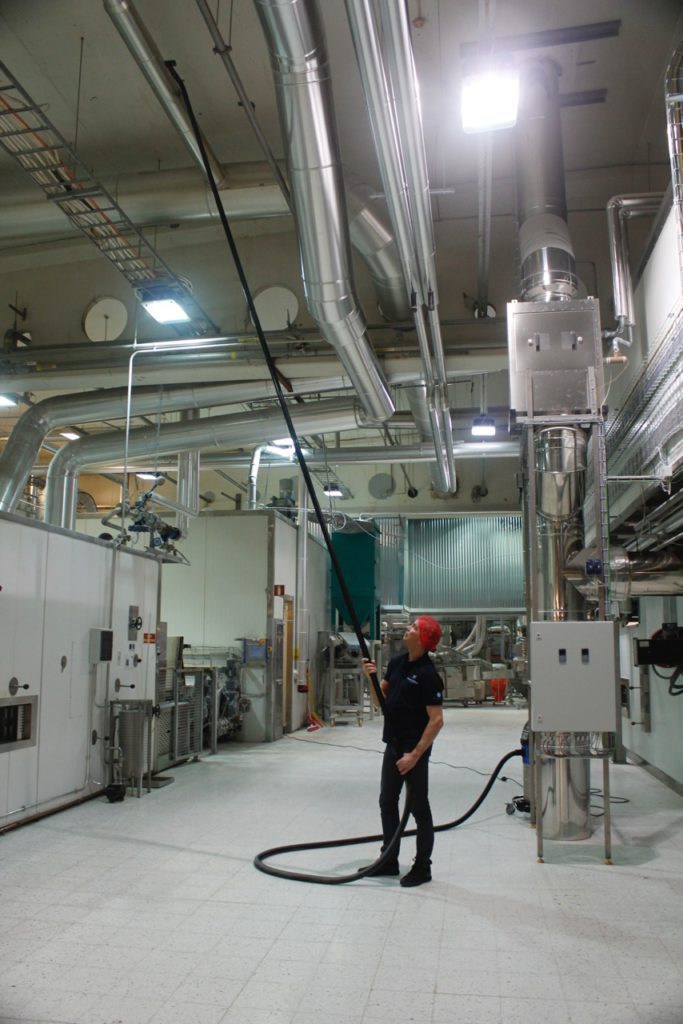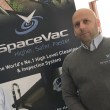Guest Author: Andy Collar Updated July 3, 22024

What do the fatal West Pharmaceutical Services Explosion in 2004 (Kinston, NC) and the Hoeganaes metal dust flash fires in 2011 (Gallatin, TN), have in common?
The severity of these devastating explosions were increased by high level combustible dust that had accumulated above the workers heads in the facility. At West Pharmaceutical, the combustible dust dust accumulated above false ceiling tiles, while at Hoeganaes, combustible dust accumulated on rafters and beams (image right).
Accumulation of combustible material and combustible dust at heights in powder processing facilities is a major concern for both primary and secondary explosion incidents. This post reviews the hazard of high-level combustible dust and describes the cleaning solution provided by SpaceVac, who specializes in equipment to clean these combustible dust areas of a facility, where hidden dust accumulates, above or near an ignition source.
The Problem
Several excerpts from the UK Health and Safety Executive guidelines for Safe Handling of Combustible Dusts (HSG103) illustrate the importance of high-level combustible dust cleaning:
“Air currents will carry the finest combustible dust particles a considerable distance and allow them to settle at high levels within a building. Combustible dust deposits on beams and ledges at high level create a secondary explosion risk.”
“Do not neglect the highest parts of buildings as these are the areas where the finest and most hazardous combustible dust can be found. “
“..the preferred [cleaning] method is a vacuum system rather than brushes and shovels, which tend to raise dust clouds. You should avoid the use of compressed air lines to dislodge dust deposits as this will cause unnecessary dangers by creating dust clouds.”
These excerpts illustrate that combustible dust cleaning services, equipment, safety, and housekeeping practices which ignore the higher parts of the facility including the top of machinery, pipework, cable trays, and ducting expose workers to significant combustible dust accumulation, a possible flash fire, and how combustible dusts poses secondary dust explosion hazards.
Area Classification
These specialist environments are designated as ATEX environments – named after the European directive governing hazardous environments and the explosion proof vacuums and equipment required to work within them for safety. ATEX covers a range of designations based on the particular hazard but most of the food & drink operators, tend to fall within the zones 21, 22 designation covering dry food storage and handling.
An At-Risk Industry
One of the first sectors that quickly saw the need to remove high level combustible dust was the Food & Drink sector with facility’s operations dealing with the issues our system set out to help resolve. By its very nature, Food & Drink oftentimes requires the transportation, storage and food processing of all kinds of raw ingredients, from flour and wheat through to sugar, salt, pepper and many more. When working with these materials, dust accumulates, and there are always residual dust left behind which, due to the light weight of the combustible dust particles, will often float upwards and settle on the way back down to surfaces. These surfaces include on top of machinery, pipework, ducting and anything else standing between it and the floor, as a result, combustible dust poses safety challenges with access to remove the dust. This situation is creating combustible dust safety hazards, a possible flash fire hazard, and indoor air quality hazards, requiring specialized combustible dust cleaning services, per osha requirements, with proper ppe, equipment, and safety training.
While some sugar cast-offs might not seem like a huge issue on first glance, as regular readers of this site will be aware, these kind of combustible dust organic matters, when in a confined space and deflagrated dispersed into regular air can be especially hazardous, creating the perfect environment for an explosion (deflagration)! In these situations, all that would be required to ignite a massive explosion would be a source of heat i.e. a single static spark or other ignition source. As a result, it is crucial that food & drink operators not only deploy the correctly rated safety equipment but also maintain regular cleaning and maintenance to prevent the build up of these potentially combustible materials, fire hazards, indoor air quality, and combustible dust hazards.
With regards to combustible dusts, in order to have an explosion, there must confinement of the flame propagating in the dust-air mixture. Confinement is the final element making up the combustible dust explosion pentagon. With confinement of the propagating flame front, pressure will rise which may cause rupture of the enclosure. Any confinement or confined space, can lead to pressure rise, acceleration of the flame, or pressure piling, which can all increase the explosion violence, and facility’s safety.
The SpaceVac Solution

SpaceVac is a revolutionary high-level combustible dust cleaning system that provides a fast, cost efficient and safe way of cleaning high surfaces and confined spaces, to remove combustible dust, inside and out from the safety of the ground floor, without the use of aerial lifts and aerial platforms. This process prevents a fire and explosion hazard, prevent secondary combustible dust explosions, and improve indoor air quality in food processing and industrial facilities.
The system is built around a set of lightweight carbon fibre cleaning poles and vacuum hoses, accessorized with a range of specialized equipment such as heads, tools and brushes to offer a combustible dust cleaning solution for cleaning guttering, downpipes, hoppers, ducting, pipework, vents and much more, where hidden dust accumulates. The flexible, interconnecting equipment system allows the operator to access even the toughest to reach and most inaccessible dust areas without the need for ladders, scaffolding or cherry pickers, to mitigate risks from dust explosions and increase safety.
SpaceVac also produces an ATEX certified version of its system (protected by a worldwide patent) that enables the technology to be utilized in ATEX designated explosive atmospheres and explosion proof vacuums, in industrial facilities, compared to a non explosion proof vacuums such as a shop vac. In addition, the National Fire Protection Association provides standards, on the safe removal of the hazardous dusts and by-products that can accumulate in these areas is a crucial part of Facilities Management, in these specialized environments.
To learn more about the SpaceVac solution and how it can help your high-level combustible dust cleaning and professional cleaning company needs, visit their website spacevacinternational.com.
References:

Andy Collar is the Technical Manager of SpaceVac International – overseeing the entire design and manufacture process. Andy’s considerable expertise in ATEX was a driving force behind the development of the SpaceVac ATEX Cleaning System.
